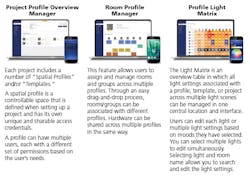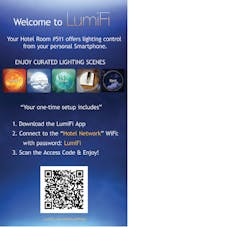Software-based controls built on top of IoT-enabled hardware will add flexibility and personalization to SSL systems, explains BEATRICE WITZGALL. The newly-enabled features will also change forever the specification process.
Software-enabled lighting controls, enabled by the smart lighting and Internet of Things (IoT) evolution, will be a game-changer in the world of lighting and will ultimately transform the industry. Such controls promise to be among the biggest growth drivers, as the flexibility and personalization aspects of the move to software will unlock new functionalities and applications. Still, the solid-state lighting (SSL) industry faces the challenge of developing easy-to-use systems: The supply chain must figure out how to bring such capabilities to the market and what functionalities they offer; and the specification community must plan for that functionality and deliver on the promises. Let's consider the architecture of such a system and specific examples of software features that can operate on top of such an architecture.
Software-enabled lighting controls are designed for simplicity, bringing IoT capabilities to lighting specifiers and end users without advanced programming.
First, a connected lighting system is requisite. The benefits of a wireless system are obvious in the day of the mobile phone and technologies such as Wi-Fi, although wired connectivity such as Power over Ethernet (PoE) may find use in some new construction. In general, wireless offers more features, flexibility, and simplicity for a fraction of the price and requires substantially less infrastructure and skilled labor to install. While many in the lighting industry have heard and acknowledged that wireless is the future, very few have understood how it impacts them or how to specify it.
The components of an IoT-based lighting control system are different from legacy control systems. You start with an IoT-enabled luminaire, which is one that has a wireless communication chip - may it be Bluetooth or ZigBee or another wireless protocol - directly integrated into the LED board, chip, bulb, or driver. No additional control hardware is needed other than perhaps a gateway to the Internet. Software access to the smart luminaire is provided by an application programming interface (API) that is offered by the luminaire hardware manufacturer. An article in LEDs Magazine covered this architecture in more detail last year.
Lighting control software
The next major component of the architecture is the lighting control software that enables the functionalities and makes the system intelligent. This change to a software-centric architecture also changes the way controls are being specified. It's not a separate task anymore that is done after the bid or by the engineer or a control specialist. It is decided when designing the space and selecting the luminaires. The specifier now has to select the IoT-enabled luminaire as well as the software with its flexible and novel features set. In fact, the software can now be directly purchased with a registration on a website and it doesn't require the traditional hardware distribution channel with countless markups anymore. This is where the real industry disruption comes in. The advantages are on the client side as they get more features and functionalities for a lower cost.
The software that drives the integrated wireless LED functionality is now a key component in offering a control solution. The software capabilities unlock functionalities with endless new possibilities. With simple over-the-air updates, these can continue to evolve and deliver new features. Look at Tesla and how it transformed the car industry into a software business and increased its value tremendously. With software driving the controls, we are now able to overcome hardware limitations and reduce manual, onsite programming to offer more flexible and personalized experiences. But does the specification community really understand this opportunity and the options that this technological advancement is bringing in designing an experience?
Although various manufacturers already offer IoT-enabled capabilities, often the specification documentation trails behind. Documentation may only identify that a fixture integrates Bluetooth capabilities or is ZigBee based, but the documentation doesn't make clear what features and new capabilities this technology unlocks and enables.
Many in the specification community are still in the ancient "set-and-forget" mentality, thinking that setting four light scenes and meeting a status quo is all that a control system needs to offer (http://bit.ly/2E4wZ2q). But set-and-forget must become a thing of the past. IoT-enabled lighting controls offer new techniques and features, such as personalization and dynamic lighting or integration of algorithms, with many more applications that still need to be imagined and developed by the design community.
The questions that stand out here are: Is the specification community aware of some of these new functionalities? Is the community able to specify them?
IoT software-enabled control features and functionalities
To give both product developers and lighting specifiers an understanding of the breadth of what might be possible, let's consider some examples of software controls. The following list includes selected software feature examples that are part of LumiFi's offering.
The light setting "Personalization" offers the ability to intuitively customize scene settings without the need of an expert or programmer and having the ability to adjust and modify them to the user's personal preferences. These can be set up in conjunction with Project Default Light Settings, allowing the user to always reset them to the original designed settings.
Easy-access instructions for a hotel guest illustrate the value of implementing software-based controls that can be delivered in a familiar way.
"Sharing" of project light settings enables seamless sharing between users. A Scan & Go functionality easily connects and shares the lighting control of a space to any user's smartphone. LumiFi enabled this feature by creating profile QR codes that can simply be scanned from a mobile app to open the access to the lighting controls in any space. Consider an example. This is a great application for any patient in a hospital who is tied to a bed with the light switch by the door or a guest in a hotel room who is not familiar with the traditional manual light switch locations and always ends up searching for them.
"Personalized Profiles" are settings that are specific to people. Here users can set their own preferences, e.g., I like my lights dimmed with certain hues while my elderly mother prefers everything brighter and colder whites when she is visiting. A space can now have multiple personalized user profiles with customized light settings. This is also an important feature when considering jetlag mitigation or work performance improvements in human-centric lighting applications for homes, hotel rooms, or offices.
"Personalized Access" offers highly customizable interfaces that define access to specific features and selected functionalities for a user. This simplifies the interfaces and makes for an intuitive user experience. For example, a designer or project owner has access only to modify light scene settings or setup schedules without having access to technical aspects such as IT or network settings that potentially can break the operation of the system. You can manage such a feature through a systems login and set of associated permissions. In the LumiFi case, this feature allows us to restrict control to users by providing roles with attached permissions for access and functionality.
"Personalized Control" provides access to specific areas or spaces for any user profiles. These profiles can be personalized and specific for any individual user. A user can customize light settings and select different rooms or areas to be controlled according to their preference. For example, you can give selected or curated lighting control access to only certain areas of a property to a guest. In the LumiFi case, we manage the feature through a Room Profile Manager.
"Portable Lighting Experiences" allow users to share their lighting preferences between various locations. A Personalized Profile is specific to a person as it includes their light scene definitions with their personalized settings. These settings are portable between locations and are being abstracted by fixture and illumination types then applied to the characteristics of the new space. For example, if a user prefers their nighttime mode set as 20% brightness at 2400K for their desk lamps, these settings will be applied to any new space that has a desk lamp.
"Personalized Scheduling" features allow individual users to set their own wakeup and sleep timers or schedules in their own space to their personal preferences.
"Intuitive Interfaces" is a tool that allows users to create meaningful interfaces that visually represent the atmosphere and feeling of the space, and that can be customized for different user applications or brands. This means users can upload their own designs in the LumiFi Lightscene Manager and enable new and unlimited lighting scenes.
"Configuration Templates" provide the ability to adjust lighting scene settings for a complete building by one simple click on a user-facing web-interface. With the ability to create a project hierarchy with such templates, a space with similar characteristics such as an office space, hotel or hospital rooms, and corridors can be set up as linked instances to each other and are able to be edited with one action. Imagine all 30 corridors on different floors of a building are identified to be too dim at night. With one click, all of these locations can be made brighter in a simple manner. This saves an incredible amount of programming time as not every light setting has to be locally adjusted onsite, on a piece of hardware. Instead, this operation can be performed remotely from the comfort of someone's office, saving the clients hours and even days of manual, expensive configuration work.
"Usage Behavior" enables monitoring of lighting use within a space and different user interactions with lighting and their behavior. This feature provides a better understanding of what kind of lighting makes sense for different applications and their users' preferences.
"Data Analytics" provide the ability to give feedback to the user, such as the status of hardware, and report accurate and dynamic energy usage statistics so the user knows where they are saving the most energy and where they can save more.
"Algorithms" is a functionality enabling custom software lighting controls, which offers the ability to infuse programmatic elements into how lighting is controlled and makes it not only dynamic but also personalized. Such programmatic capability is one of the fundamental requirements to develop human-centric lighting on a larger scale and additional applications. Human-centric lighting, or lighting for health and wellbeing, and circadian health are much discussed. But for such applications to really take off, we need a flexible, wireless, and software-based lighting control infrastructure that allows for these algorithms to be executable.
This overview offers just the beginning of what the new generation of lighting controls can enable. All these new features are managed by ever-evolving software that delivers features to the lights with simple over-the-air updates.
When the first digital photography took over analog film-processing techniques, taking a big stable like Kodak out of business, would anyone have imagined today's "selfie culture" as a result? Lighting is going through a similar evolution. We are just at the beginning and still need to imagine all the various applications of what lighting can do for us - and how it can be done in a simpler, faster way. Lighting can become smart, dynamic, and personalized. The design community has the opportunity to redefine lighting experiences, create new interactions in any space, and develop more functionalities.
BEATRICE WITZGALL is CEO of LumiFi.







